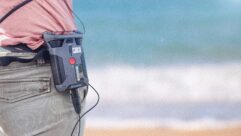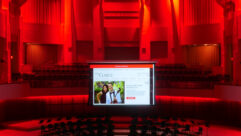Changing times
Feb 1, 1999 12:00 PM,
Gregory A. DeTogne
In the dawn of the wireless world, audio professionals approached each daywith a strong measure of apprehension. Although the passage of time andevolution of technology have calmed those initial fears, the initialskepticism was rooted in more than the anticipated fear of the unknown. Asanyone who was there can attest, the first wireless mic systems were a farcry from the products available in the modern marketplace.
Despite the shortcomings of early wireless mic systems, credit should begiven to the technological pioneers who developed them; it was theirefforts that established the groundwork that will lead us into the 21stcentury with power and flexibility. Today, a vital and maturing wirelessmarketplace is coming of age, not only in the world of audio, but also insuch realms as computer networking, telephone and Internet access. Formanufacturers, meeting wireless needs is no longer just a question ofrealizing performance goals; it is one of meeting increasingly diversemarket expectations.
Sandy LaMantia, president and CEO of Shure Brothers, Evanston, IL, said,”The next century will be rich in information and driven by communication.Successful wireless manufacturers will be the ones who accurately forecastwhich technologies will serve wide-ranging user requirements best.”
These same players will also need to adapt to a global marketplace where agrowing number of regulatory edicts will govern wireless spectrum realestate in an attempt to parcel out a pie which may simply not have enoughfor everybody. Most wireless designers know such constraints andlimitations will affect wireless integrators. They feel, however, that muchof today’s wireless hardware will remain viable for most applications wellinto the next decade. As users and system integrators become moreenlightened about the ways in which they can solve both the current andupcoming conflicts, matters will continue to improve.
Although his responsibilities are global in scope, Edgar Reihl, principalRF engineer at Shure, has been kept busier than usual right here in theUnited States. Reihl leads the formidable task of unraveling the trueimpact of two recent regulatory actions taken by the FCC that have sentshock waves of uncertainty through the audio industry. The first concernsthe establishment of digital television (DTV) transmission standards andthe 10-year transition period allotted broadcasters for the mandatorychangeover from analog to digital broadcasting. The second, which hasprobably created as much confusion as the first, involves the reallocationof four of the upper UHF TV channels to public safety communications.
To understand the scope of the challenges to wireless system operation thefirst of these FCC actions poses both today and for tomorrow, it isimportant to realize that most professional wireless audio systems operateon unused channels in the VHF and UHF TV bands according to guidelineslisted under Part 74 of current FCC rules. Within the Part 74 bands,wireless systems are classified as secondary users, meaning that they mustnot interfere with primary users, namely TV broadcasters, and they mustaccept that primary users may cause interference with their operation. Mostcommonly, wireless systems circumvent potential clashes with broadcastersby using unoccupied TV channels.
DTV and wirelessWith the advent of digital television broadcasting, however, the finitenumber of unused channels is decreasing rapidly. During the duration of theDTV transition period scheduled for completion in 2006, the number ofon-air TV signals may double because of the FCC’s decision thatbroadcasters should make the switch from analog to digital easier onconsumers by broadcasting in both formats on separate channels untilconsumers have time to convert their old televisions or buy new digitalsets. The best way to determine if the wireless mic gear you are currentlyusing conflicts with the new scheduled DTV assignments is to consult theFCC’s Table of Allocations (available on the FCC Web site: www.fcc.gov).Wireless users need not rush to this chart in a state of panic. Reihl saidthat most new DTV assignments will be between channels 2 and 51, which iswell below the range of most professional-grade UHF wireless mic systems.
Because the FCC plans to assign only four new DTV stations in channels 66through 69, Reihl said, “Most areas of the United States will still haveenough open channels available to satisfy all but the largest wirelessinstallations.”
In the event of a conflict, Reihl said, “With a frequency-agile system,just turn to another channel. On most systems, compatible frequencies aregrouped for easy avoidance of specific TV channels. If you have anon-synthesized system incapable of changing to a non-conflictingfrequency, you will probably have to re-tune it. Shure, like mostmanufacturers, provides this service to its users for a nominal fee.”
What is more interesting is that research suggests that wireless systemsmay be able to coexist with DTV signals more easily than with analog TVsignals. This conclusion is based in part on the fact that DTV signals arespread out more uniformly than analog TV signals, thereby posting lowerpeak power levels. If you look at a DTV signal on an analog TV or listen toone on a wireless receiver, what you will experience is that it isessentially noise-like because of the digital nature of the transmission(see Figure 1). Therefore, wireless receivers using noise-squelch circuitrywill interpret DTV signals as noise and suppress them. It should be noted,however, that even with squelch circuitry, the DTV signal energy is stillpresent. As is always the case, whether or not a wireless system will beusable depends upon the relative strength of the transmitter signalcompared to that of the undesired DTV station.
Public safetyWith all of the ruckus recently generated by the FCC’s DTV ruling, the lastthing wireless mic users wanted to hear about was the establishment of newpublic safety bands that will be used by police, firefighters, rescuesquads and other emergency service providers. Thanks to the Balanced BudgetAct of 1997 in which the U.S. Congress directed the FCC to allocate up to24 MHz of spectrum between TV channels 60 and 69 for their application,these bands will become a reality. As originally proposed, the FCC rulingwould have dedicated TV channels 63 and 64 (764 MHz and 776 MHz) plus 68and 69 (794 MHz and 806 MHz) to public safety operations. All existing TVstations and secondary users of wireless systems using these bands wouldhave had to abandon these frequencies.
“Wireless users were almost completely lost in the shuffle,” Reihl said.
In response to the FCC decree, Shure [and other manufacturers] filed formalcomments requesting that wireless audio transmitters be allowed to maintaintheir secondary user status within these bandwidths. When all was said anddone, the FCC granted the request. The success of this regulatory advocacyhas benefited the entire audio industry by retaining legal use of theseimportant channels.
“It’s useful to realize another issue regarding the new public safetybandwidths,” Reihl said. “The FCC determined that now is also a good timeto implement digital transmission for these users. To accomplish this, newequipment needs to be developed, which will take time, and existingwireless audio components need to be made usable for the foreseeablefuture.”
The FCC has designated the lower public safety bands (TV channels 63 and64) for base-to-mobile transmission and the upper bandwidths (TV channels68 and 69) for mobile-to-base transmission.
“For the wireless user, this means that the bottom 3 MHz of TV channels 63and 68 and the top 3 MHz of channels 64 and 69 will be occupied bynarrowband digital transmissions,” Reihl said. “The top 3 MHz of channels63 and 68 and the bottom 3 MHz of channels 64 and 69 will be used bywideband digital transmissions. Interference from narrowband signals ismuch easier to avoid. Because public safety frequency selection will mostlikely continue to be handled by regional planning committees, it shouldn’tbe difficult to determine in advance which frequencies will need to beavoided.”
All things considered in the regulatory world here in the United States,now is a good time to examine the future of wireless hardware technologiesand the state of wireless market needs around the globe. Can such a thingas world wireless actually exist? Technically, it is a fairly safe bet thatit could. Legally, however, it may be doubtful, given the number ofdifferent bandwidth plans embraced by various countries around the world.After all, the equivalent of our FCC in Sri Lanka-or any other agencyregulating such matters anywhere else-might not want to provide audioprofessionals with a single device capable of operating on bandwidths thatit had banned from wireless use. It would, in most cases, be unlikely,thereby limiting the number of countries in which such a device could belegally sold. Within the context of a global platform, Rob Cappucci,director of wireless products for Shure, predicts that the day willultimately arrive when wireless mic systems are offered that allow usersand systems integrators alike to forget about technology completely.
“Wireless audio will be self-sufficient,” Capucci said. “You won’t evenhave to remember that there’s an RF transmitter and receiver. A wirelesssystem will simply be one that doesn’t have cords. You’ll be able to turnit on like a light switch, and it will work. It may be capable of bothvoice and data communications. The business of locating open channels andthen monitoring them to make sure they are free from interference will beunnecessary. The system will do all of that for you. If you add morechannels yourself or if the church next door buys a dozen of its ownsystems in the future, your wireless system will continue to take care ofitself and function flawlessly.”
You cannot help but wonder what kind of role digital designs may playwithin this view of the future. Steve Johnson, Shure vice president ofmarketing, sees wireless audio following a technically enabling path wheredigital will reign, but he will not exclude the use of other analog-basedplatforms.
“Analog, digital, VHF, UHF-we have a tendency to get hung up on theseterms,” Johnson said. “At various points during the progression of wirelessaudio, VHF was perceived as better than what people referred to as FM band.Then UHF was better than VHF, and digital was better than analog. Just aswe experienced with the evolution of the cordless telephone in the consumerworld, there will come a time in the future when we all realize that eachone of the current wireless technologies available has its share ofadvantages and limitations. For instance, a well-designed VHF system cansound as good as a UHF system in certain applications, while a digitalsystem may actually sound worse than analog at times. It’s all dependentupon what a given system’s goals are and the purpose that needs to befulfilled.
“The future will be driven by users,” Johnson said. “Successfulmanufacturers will be those who meet user needs by offering flexiblesystems that allow them to buy into whatever part of the dream they need ata price they can afford.”
Many within the industry today feel that digital’s recent entry into thewireless mic market has taken such a disruptive route with the arrival ofthe low-priced, 16-bit products seen within the last year.
“These low-priced digital systems are a lot like a point-and-shoot camera,”Johnson said. “They deliver a lot to the user but not everything. Whateveryou think about their presence in the marketplace, you have to admit it’s apretty good start. For better or worse, they’ve set the tone for tomorrowby establishing certain expectations and an idea of what digital should doat what kind of price. The wireless market can be fickle. Groundbreakingproducts don’t necessarily require a lot of research and development.”
Given the likely prospect of a wireless future where the current allowablespectrum space becomes even more scarce, other frequency allocations willbe necessary. Among the alternatives available are Part 90 business-bandchannels and the consumer product-dominated but license-free Part 15 bandsat 900 MHz and 2,400 MHz that permit the use of spread-spectrumtransmission. Out of all of these, there is no spectrum space that isdefinitively better than what wireless audio currently occupies.
“Higher power is permitted, but spectrum space and current hardwaretechnologies severely limit the number of systems you can usesimultaneously,” Reihl said of spread spectrum possibilities. “Regulationsgoverning that of transmission aren’t favorable either. There are pitfallswith all the alternatives. For right now, sharing space with TVbroadcasters still appears to be the way to go.”
Be warned that this may not remain the status quo forever. As with anythingelse viewed through the sometimes cloudy sphere of a crystal ball, nothingcan be said about tomorrow with absolute certainty until we actually arrivethere. Educate yourself and your clients, and remain prepared or change.










